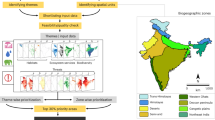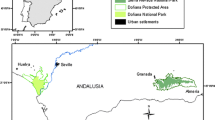Abstract
In the evolution of the models for the establishment and management of protected natural areas, we assist to the transition from “sanctuaries” of nature, where men are considered exclusively a threat or an interference to eliminate, to tools for conservation of biological diversity in situ through the involvement of local communities. This vision of protected natural areas has been formalised in the International Convention on Biological Diversity and its Action Plans. To implement the CBD in 2000, a new method has been developed that considers the human communities as part of the ecosystems and of their governance assets, called “ecosystem approach”. The ecosystem approach recognises that human activity affects ecosystems interacting with their structure and composition, resulting in an irreversible loss of ecosystem functionality once some boundaries are crossed. At the same time the ecosystem approach recognises particular importance to the role of local communities and traditional knowledge in the definition of strategies and programmes for the conservation of biodiversity. The ecosystem approach requires the definition of clear targets of biodiversity conservation and the identification of the most appropriate community to deal with its management. The introduction of territory’s perception by local communities in defining the European Landscape Convention is echoed in the approach of the CBD ecosystem, particularly for Italy, where the high biodiversity is matched by a high cultural diversity of local traditions and customs. The application of the ecosystem approach to the landscape scale requires a coherent planning approach that includes a proper biodiversity’ conservation plan. These targets must be identified not only for the conservation of each species or habitat but rather for the maintenance of the structure and functionality of the ecosystems.
Access this chapter
Tax calculation will be finalised at checkout
Purchases are for personal use only
Similar content being viewed by others
Notes
- 1.
For a more detailed description of the principles and further information on the operational guidelines for the application of the ecosystem approach, you can visit the official site of the CBD: http://www.cbd.int/ecosystem/default.shtml.
- 2.
A Centre for Environmental Education, Documentation and Interpretation, managed in cooperation with the Agricultural Society La Quercia della Memoria.
References
Battisti C, Romano B (2007) Frammentazione e connettività. Dall’analisi ecologica alla pianificazione ambientale. Città Studi Edizioni, Turin
Catorci A (2007) Lineamenti storico-economici del paesaggio pastorale maceratese. In: Catorci A, Gatti R (eds) Le praterie montane dell’Appennino maceratese, vol 42, Braun-Blanquetia. Dipartimento di Botanica ed Ecologia, Università di Camerino, Camerino, pp 39–45
Council of Europe (1979) Convention on the conservation of European wildlife and natural habitats, 19.IX.1979, Bern
Council of Europe (2000) European landscape convention. Treaty series no. 176, Florence
Crutzen P (2005) Benvenuti nell’Antropocene. L’uomo ha cambiato il clima, la Terra entra in una nuova era. Mondadori, Milan
Ferroni F, Romano B (eds) (2010) Biodiversità, consumo di suolo e reti ecologiche. La conservazione della natura nel governo del territorio. WWF Italia, Miur. Cogecstre Ed., Pescara
Foglia M, Sparvoli D, Catorci A (2007) Analisi multi-temporale dell’uso del suolo della dorsale appenninica marchigiana nel XIX e XX secolo. In: Catorci A, Gatti R (eds) Le praterie montane dell’Appennino maceratese, vol 42, Braun-Blanquetia. Dipartimento di Botanica ed Ecologia, Università di Camerino, Camerino, pp 39–45
Gambino R (2011) La pianificazione dei parchi in prospettiva internazionale. In: Sargolini M (ed) Piani per i parchi. Edizioni ETS, Pisa
Gobbi O (2003) La Villa un microcosmo ecosistemico. In: Vv.Aa. (eds) I Sibillini oltre il mito. Aspetti socio-economici di una regione appenninica nei secoli XV–XVIII. Amandola, Staff Ed., pp 165–185
Italian Ministry of Environment, Land and Sea Protection (2009a) Studio e analisi delle forme di coesistenza e criticità tra sviluppo economico-sociale e conservazione della natura. Il ruolo del processi partecipati. In: Proceedings of technical meeting Verso la Strategia Nazionale per la Biodiversità, Rome
Italian Ministry of Environment, Land and Sea Protection (2009b) Definizione del metodo per la classificazione e quantificazione dei servizi ecosistemici in Italia. In: Proceedings of the technical meeting Verso la Strategia Nazionale per la Biodiversità, Rome
Teofili C, Clarino R (2008) Riconquistare il Paesaggio la Convenzione Europea del Paesaggio e la Conservazione della biodiversità in Italia. WWF ONG/Onlus/MIUR, Rome
Vv.Aa (2006) Conservazione Ecoregionale, Reti Ecologiche e Governo del Territorio. In: Proceedings of the national conference on the Abbadia di Fiastra natural reserve. WWF Italia, UPI, Provincia di Macerata. Tolentino, 9–10 Jun 2005
Author information
Authors and Affiliations
Corresponding author
Editor information
Editors and Affiliations
Rights and permissions
Copyright information
© 2015 Springer International Publishing Switzerland
About this chapter
Cite this chapter
Ferroni, F., Foglia, M., Cioffi, G. (2015). Landscape and Ecosystem Approach to Biodiversity Conservation. In: Gambino, R., Peano, A. (eds) Nature Policies and Landscape Policies. Urban and Landscape Perspectives, vol 18. Springer, Cham. https://doi.org/10.1007/978-3-319-05410-0_28
Download citation
DOI: https://doi.org/10.1007/978-3-319-05410-0_28
Published:
Publisher Name: Springer, Cham
Print ISBN: 978-3-319-05409-4
Online ISBN: 978-3-319-05410-0
eBook Packages: Earth and Environmental ScienceEarth and Environmental Science (R0)




